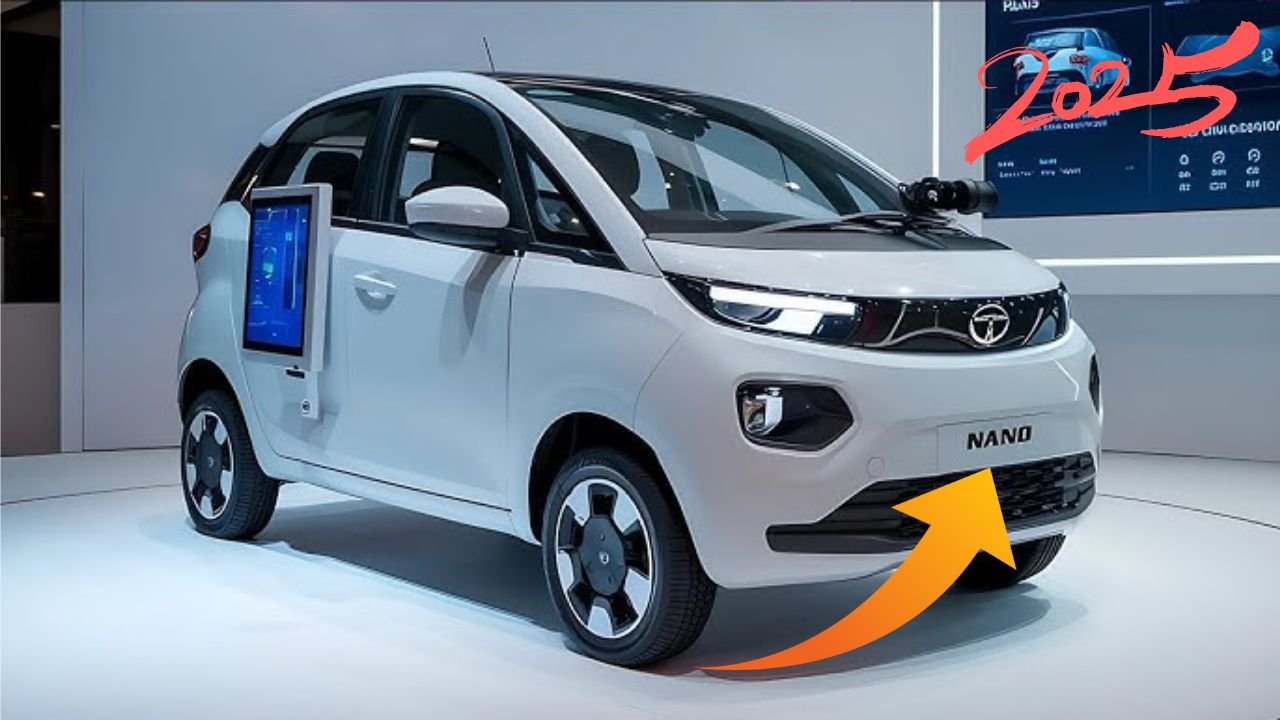Tata Nano EV 2025 in New Look with Features Like Premium EV Cars! India’s most iconic budget car, Tata Nano, is all set to return in a revolutionary electric avatar. The Tata Nano EV 2025 is not just a rebirth; it is a remarkable transformation into a futuristic urban vehicle that promises premium features, efficient performance, and a stylish design that aligns with the modern EV era. While the original Nano was known for its affordability and simplicity, the upcoming Nano EV combines those traits with modern-day electric vehicle innovation, making it an exciting option for both first-time buyers and eco-conscious drivers.
A Compact Car with a Contemporary Premium Look
The design of the Tata Nano EV 2025 is far more advanced than its predecessor. Gone is the basic and plain exterior. What you now get is a sleek, modernized body with aerodynamic curves, sharp LED headlamps, and a closed front grille that reflects the current EV design philosophy. The new avatar embraces the latest trends in small car styling, complete with stylish DRLs, attractive dual-tone color schemes, and premium alloys that elevate its overall street presence.
Inside, the story is even more captivating. The cabin of the Nano EV now offers a tech-savvy interior that includes a fully digital instrument cluster, a large touchscreen infotainment system with smartphone connectivity, and premium dual-tone upholstery. Tata has clearly taken cues from its higher-end EV models like the Nexon EV and Punch EV to give the Nano a futuristic and comfortable interior. The layout is minimal yet functional, with ample legroom and headspace that makes city commuting convenient for families.
Even though the car retains its compact footprint, Tata Motors has redesigned the cabin to maximize space and usability, making it a great pick for urban families and young professionals looking for a smart and affordable EV option.
Efficient Performance Meets Everyday Practicality
When it comes to performance and mileage, the Tata Nano EV 2025 is built to impress. Powered by a reliable 17 to 20 kWh lithium-ion battery pack, it offers a driving range of up to 250 kilometers on a single charge under ideal conditions. This range is more than sufficient for daily city commutes, short weekend drives, and even intercity trips with minimal charging stops.
The electric motor delivers quick torque and silent acceleration, which is a signature experience of most EVs. The Nano EV is expected to reach 0-60 km/h in under 10 seconds, providing a smooth and peppy driving experience, especially in city traffic. Despite being a small car, it offers impressive drivability, owing to its lightweight construction and optimized chassis design.
What truly adds to the Nano EV’s appeal is its low running cost. With electric charging being significantly cheaper than petrol or diesel, and minimal maintenance required due to fewer moving parts, this car is bound to be a game-changer in the affordable EV space.
Tata Motors has also ensured that the Nano EV 2025 supports both standard and fast charging options, enabling users to juice up the battery to 80% in just around 60 minutes using a DC fast charger. Home charging through a regular AC outlet would take around 6-7 hours, making overnight charging a practical routine for most users.
Affordability Meets Choice: Variants and Expected Price
The biggest highlight of the Tata Nano EV 2025 is its expected affordability. Despite offering premium features and cutting-edge electric technology, Tata aims to keep the Nano EV’s price under ₹6 lakhs for the base variant, making it the most affordable electric car in India.
The Nano EV is likely to be available in two to three variants, catering to different buyer needs. The entry-level variant will focus on practicality and value, while the top-end variant will include more high-tech features like auto climate control, reverse parking camera, push-button start, and enhanced infotainment options.
This strategy will allow Tata to target a wide customer base, from budget-oriented buyers to those looking for a premium small EV experience. Given Tata’s dominance in the Indian EV market with models like Tiago EV, Tigor EV, and Nexon EV, the Nano EV is expected to be a mass-market disruptor.
What’s New in the 2025 Tata Nano EV?
The 2025 version of the Nano EV isn’t just a retrofit of the old model; it’s a completely reimagined vehicle. Tata has upgraded everything from the ground up, including the platform, electrical systems, and design architecture. This allows the car to accommodate modern safety standards, battery cooling systems, and connected car technologies.
For the first time in this segment, Tata might introduce connected features like Geo-fencing, remote diagnostics, vehicle tracking, and app-based control for climate and charging status. These are typically seen in much more expensive EVs, but Tata is bringing this smart technology to the budget segment, which is revolutionary.
Safety has also been given priority in the new Nano EV. Expect it to feature dual airbags, ABS with EBD, rear parking sensors, and a strong body shell designed to absorb impact efficiently. Tata is known for its focus on safety, and the Nano EV is expected to follow suit.
The suspension and ride quality have also been improved to handle urban potholes and speed breakers, providing a more plush and stable drive than what the original Nano ever offered.
Launch Timeline and Market Availability
The Tata Nano EV 2025 is expected to be launched in India by the last quarter of 2025, with unveilings likely starting mid-year. Initially, Tata Motors will focus on top urban markets like Delhi, Mumbai, Bangalore, and Chennai, followed by a gradual rollout across Tier 2 and Tier 3 cities.
With the EV infrastructure growing rapidly in India and government incentives under schemes like FAME-II, the Nano EV is expected to benefit from attractive subsidies and lower road taxes, making the ownership even more economical.
Tata Motors may also offer easy EMI schemes, exchange offers, and dedicated EV servicing support, which will enhance buyer confidence, especially among those switching to electric vehicles for the first time.
Frequently Asked Questions about Tata Nano EV 2025
What is the expected price of Tata Nano EV 2025 in India?
The expected price range of the Tata Nano EV is between ₹5.5 lakhs to ₹6.5 lakhs, depending on the variant and state-level EV subsidies.
What will be the driving range of the Tata Nano EV?
The Nano EV is expected to offer a range of up to 250 km on a full charge under ideal driving conditions.
Is fast charging available in Tata Nano EV?
Yes, the car is expected to support DC fast charging, allowing it to charge up to 80% in approximately 60 minutes.
Will the Nano EV have smart features like connected apps?
Yes, Tata Motors is likely to offer connected car features like vehicle tracking, battery monitoring, and remote AC control via mobile app in the top variants.
When will the Tata Nano EV 2025 be available in showrooms?
The official launch is anticipated in late 2025, with bookings expected to start shortly after the unveiling.
Conclusion
The Tata Nano EV 2025 is all set to redefine what an affordable electric car can be in India. With a fresh and premium design, feature-loaded interior, smart technology, and eco-friendly powertrain, the Nano EV is clearly not just a car but a movement towards accessible electric mobility for every Indian.
While premium EVs are grabbing headlines with their luxury and performance, the Nano EV 2025 quietly stands tall as a car for the masses, with features and value that punch far above its weight. Tata Motors is proving once again why it leads the electric vehicle revolution in India, and the Nano EV might just be its most important step yet in making EVs mainstream.
Whether you are a student, office-goer, homemaker, or an environmentally-conscious driver, the Nano EV 2025 promises to be the perfect companion for your city rides—efficient, smart, safe, and stylish. Get ready, because the future of electric commuting is coming on four wheels—and it’s called Nano EV.




